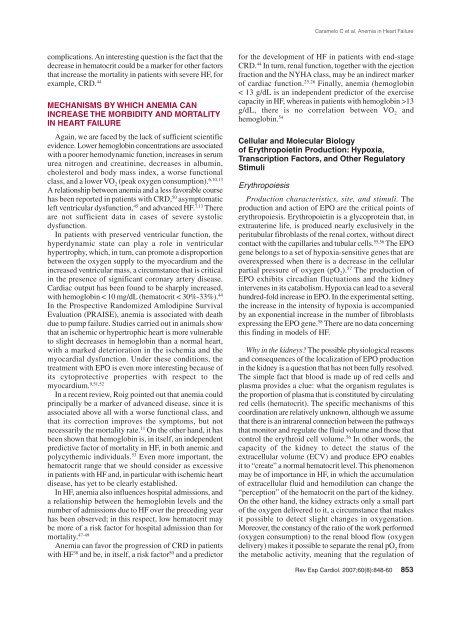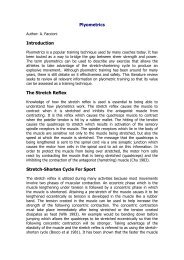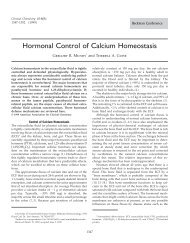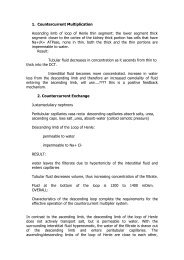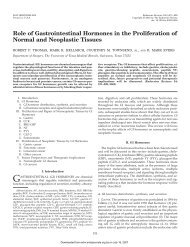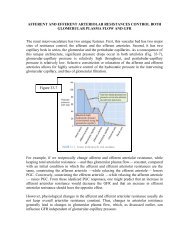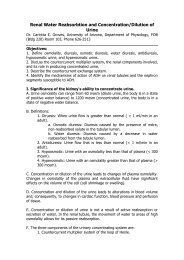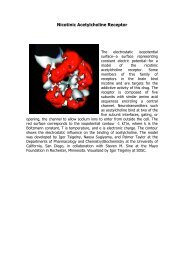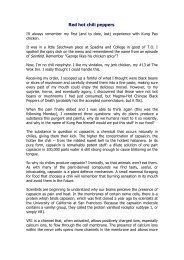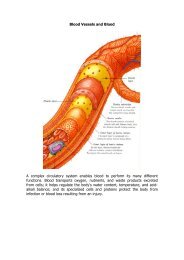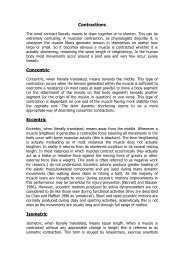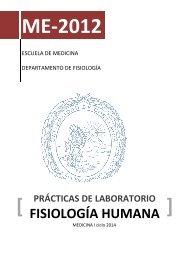Anemia in Heart Failure: Pathophysiology, Pathogenesis, Treatment ...
Anemia in Heart Failure: Pathophysiology, Pathogenesis, Treatment ...
Anemia in Heart Failure: Pathophysiology, Pathogenesis, Treatment ...
Create successful ePaper yourself
Turn your PDF publications into a flip-book with our unique Google optimized e-Paper software.
Caramelo C et al. <strong>Anemia</strong> <strong>in</strong> <strong>Heart</strong> <strong>Failure</strong>complications. An <strong>in</strong>terest<strong>in</strong>g question is the fact that thedecrease <strong>in</strong> hematocrit could be a marker for other factorsthat <strong>in</strong>crease the mortality <strong>in</strong> patients with severe HF, forexample, CRD. 44MECHANISMS BY WHICH ANEMIA CANINCREASE THE MORBIDITY AND MORTALITYIN HEART FAILUREAga<strong>in</strong>, we are faced by the lack of sufficient scientificevidence. Lower hemoglob<strong>in</strong> concentrations are associatedwith a poorer hemodynamic function, <strong>in</strong>creases <strong>in</strong> serumurea nitrogen and creat<strong>in</strong><strong>in</strong>e, decreases <strong>in</strong> album<strong>in</strong>,cholesterol and body mass <strong>in</strong>dex, a worse functionalclass, and a lower VO 2(peak oxygen consumption). 6,10,13A relationship between anemia and a less favorable coursehas been reported <strong>in</strong> patients with CRD, 50 asymptomaticleft ventricular dysfunction, 45 and advanced HF. 7,13 Thereare not sufficient data <strong>in</strong> cases of severe systolicdysfunction.In patients with preserved ventricular function, thehyperdynamic state can play a role <strong>in</strong> ventricularhypertrophy, which, <strong>in</strong> turn, can promote a disproportionbetween the oxygen supply to the myocardium and the<strong>in</strong>creased ventricular mass, a circumstance that is critical<strong>in</strong> the presence of significant coronary artery disease.Cardiac output has been found to be sharply <strong>in</strong>creased,with hemoglob<strong>in</strong> < 10 mg/dL (hematocrit < 30%-33%). 44In the Prospective Randomized Amlodip<strong>in</strong>e SurvivalEvaluation (PRAISE), anemia is associated with deathdue to pump failure. Studies carried out <strong>in</strong> animals showthat an ischemic or hypertrophic heart is more vulnerableto slight decreases <strong>in</strong> hemoglob<strong>in</strong> than a normal heart,with a marked deterioration <strong>in</strong> the ischemia and themyocardial dysfunction. Under these conditions, thetreatment with EPO is even more <strong>in</strong>terest<strong>in</strong>g because ofits cytoprotective properties with respect to themyocardium. 9,51,52In a recent review, Roig po<strong>in</strong>ted out that anemia couldpr<strong>in</strong>cipally be a marker of advanced disease, s<strong>in</strong>ce it isassociated above all with a worse functional class, andthat its correction improves the symptoms, but notnecessarily the mortality rate. 11 On the other hand, it hasbeen shown that hemoglob<strong>in</strong> is, <strong>in</strong> itself, an <strong>in</strong>dependentpredictive factor of mortality <strong>in</strong> HF, <strong>in</strong> both anemic andpolycythemic <strong>in</strong>dividuals. 53 Even more important, thehematocrit range that we should consider as excessive<strong>in</strong> patients with HF and, <strong>in</strong> particular with ischemic heartdisease, has yet to be clearly established.In HF, anemia also <strong>in</strong>fluences hospital admissions, anda relationship between the hemoglob<strong>in</strong> levels and thenumber of admissions due to HF over the preced<strong>in</strong>g yearhas been observed; <strong>in</strong> this respect, low hematocrit maybe more of a risk factor for hospital admission than formortality. 47-49<strong>Anemia</strong> can favor the progression of CRD <strong>in</strong> patientswith HF 38 and be, <strong>in</strong> itself, a risk factor 50 and a predictorfor the development of HF <strong>in</strong> patients with end-stageCRD. 44 In turn, renal function, together with the ejectionfraction and the NYHA class, may be an <strong>in</strong>direct markerof cardiac function. 25,26 F<strong>in</strong>ally, anemia (hemoglob<strong>in</strong>< 13 g/dL is an <strong>in</strong>dependent predictor of the exercisecapacity <strong>in</strong> HF, whereas <strong>in</strong> patients with hemoglob<strong>in</strong> >13g/dL, there is no correlation between VO 2andhemoglob<strong>in</strong>. 54Cellular and Molecular Biologyof Erythropoiet<strong>in</strong> Production: Hypoxia,Transcription Factors, and Other RegulatoryStimuliErythropoiesisProduction characteristics, site, and stimuli. Theproduction and action of EPO are the critical po<strong>in</strong>ts oferythropoiesis. Erythropoiet<strong>in</strong> is a glycoprote<strong>in</strong> that, <strong>in</strong>extrauter<strong>in</strong>e life, is produced nearly exclusively <strong>in</strong> theperitubular fibroblasts of the renal cortex, without directcontact with the capillaries and tubular cells. 55,56 The EPOgene belongs to a set of hypoxia-sensitive genes that areoverexpressed when there is a decrease <strong>in</strong> the cellularpartial pressure of oxygen (pO 2). 57 The production ofEPO exhibits circadian fluctuations and the kidney<strong>in</strong>tervenes <strong>in</strong> its catabolism. Hypoxia can lead to a severalhundred-fold <strong>in</strong>crease <strong>in</strong> EPO. In the experimental sett<strong>in</strong>g,the <strong>in</strong>crease <strong>in</strong> the <strong>in</strong>tensity of hypoxia is accompaniedby an exponential <strong>in</strong>crease <strong>in</strong> the number of fibroblastsexpress<strong>in</strong>g the EPO gene. 58 There are no data concern<strong>in</strong>gthis f<strong>in</strong>d<strong>in</strong>g <strong>in</strong> models of HF.Why <strong>in</strong> the kidneys? The possible physiological reasonsand consequences of the localization of EPO production<strong>in</strong> the kidney is a question that has not been fully resolved.The simple fact that blood is made up of red cells andplasma provides a clue: what the organism regulates isthe proportion of plasma that is constituted by circulat<strong>in</strong>gred cells (hematocrit). The specific mechanisms of thiscoord<strong>in</strong>ation are relatively unknown, although we assumethat there is an <strong>in</strong>trarenal connection between the pathwaysthat monitor and regulate the fluid volume and those thatcontrol the erythroid cell volume. 56 In other words, thecapacity of the kidney to detect the status of theextracellular volume (ECV) and produce EPO enablesit to “create” a normal hematocrit level. This phenomenonmay be of importance <strong>in</strong> HF, <strong>in</strong> which the accumulationof extracellular fluid and hemodilution can change the“perception” of the hematocrit on the part of the kidney.On the other hand, the kidney extracts only a small partof the oxygen delivered to it, a circumstance that makesit possible to detect slight changes <strong>in</strong> oxygenation.Moreover, the constancy of the ratio of the work performed(oxygen consumption) to the renal blood flow (oxygendelivery) makes it possible to separate the renal pO 2fromthe metabolic activity, mean<strong>in</strong>g that the regulation ofRev Esp Cardiol. 2007;60(8):848-60 853


